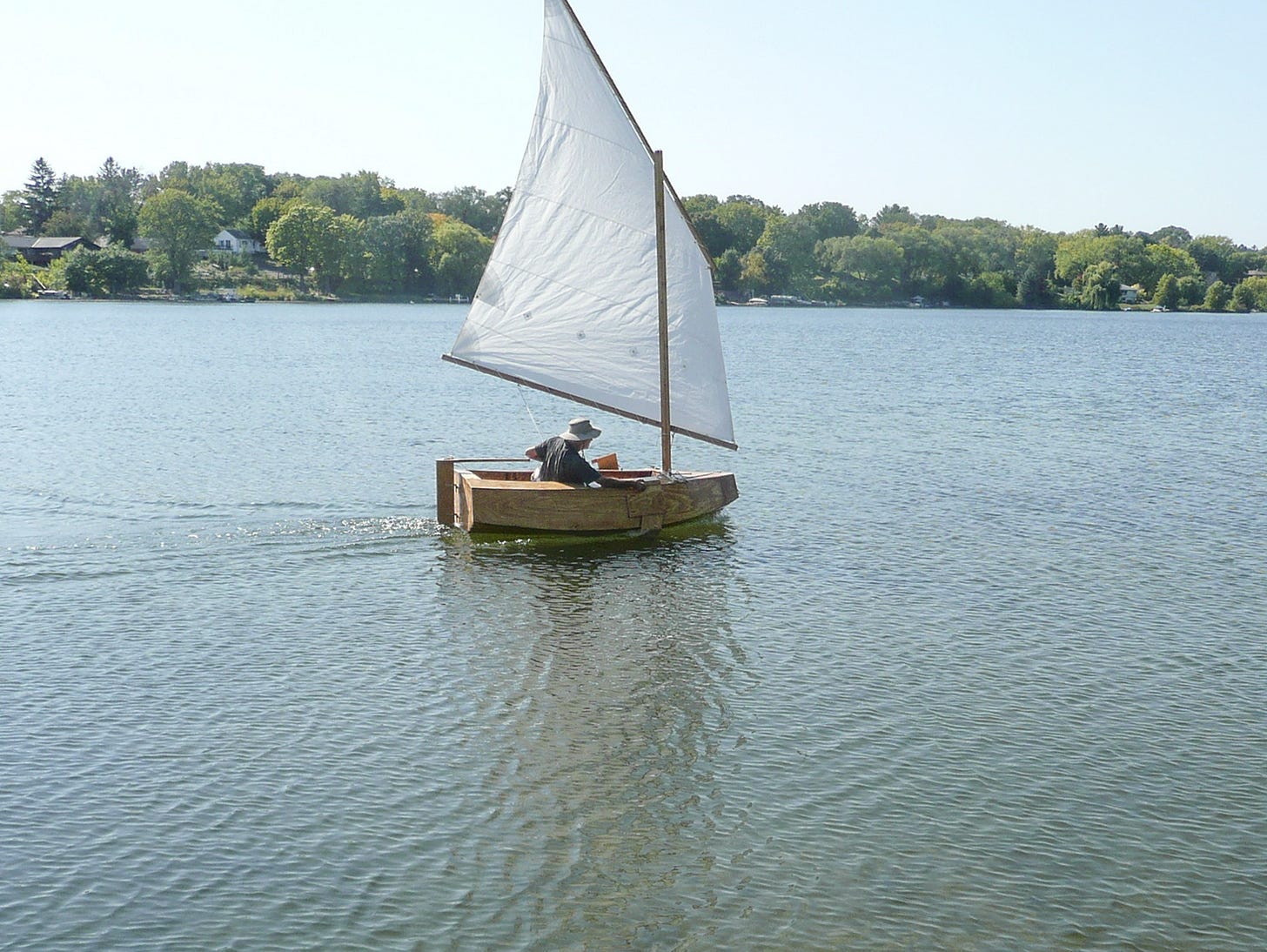By Bill Mantis • Photos by Peter O’Brien
At 8.5’ x 4.5’ with a hull weight of approximately 90 pounds, City Slicker 2.0 is two-thirds the size and one-half the weight of her namesake City Slicker 1.0. The smaller size gave me a boat that I could drag onto and off of a flatbed trailer without assistance, and a boat that would lend itself to being maneuvered down a boat ramp on a dolly or cart of some sort. A cart that could convey my boat from a parking lot to a ramp would save me having to back the trailer down the ramp. It would also mean I could avoid getting my trailer’s wheels—and their bearings—wet. Plus, a boat that slides easily off a trailer means the trailer can be used for other purposes; like hauling plaster board, furniture, landscaping equipment, etc.
The ramp cart I devised attaches to the boat’s transom. Two barrel bolts drop into the gudgeons that serve as the rudder’s hinge mechanism, holding the cart in place. On the bow, I mounted a stainless steel door pull handle instead of a conventional bow eye. I’ve started using a shoulder strap to carry some of the boat’s weight when rolling it up or down the ramp. I use a piece of polyethylene foam packing material to protect the boat’s bottom when I slide the hull onto the trailer: simply leaving the foam under the hull until my next sail.
Materials needed to build the CS 2.0 ramp cart:
· One piece of ½ inch plywood, approximately 1.5’ x 2’
· Two barrel bolt latches
· One 1.5’ length of 2 x 6
· One 1.5’ length of 5/4 x 6
· One 2’ length of ½ inch threaded rod to serve as the axle
· Five ½ inch conduit or pipe straps to anchor the axle to the 2 x 6
· Four ½ inch lock nuts
· Two 8” wheels. I bought mine from Harbor Freight
· Two metal sleeves to occupy the gap between axle and wheel hub.
· Epoxy for fastening the barrel bolts to the plywood
The assembly procedure is mostly self-evident except for the one construction detail called out in the diagram. The barrel bolts cannot be mounted flat on the plywood. A wedge of plywood must be removed so that the bottom of the “bolts” angle forward, towards the transom. Otherwise, the gudgeons and bolts will not be aligned properly.
I would like to add a couple more caveats. 1) I don’t think this cart design would work well with a hull that weighed more than 175 pounds. 2) I’m sure it would not work well on a beach or on loose sand or gravel. If you’re looking for a dolly that will roll over a sandy beach, you’ll need larger, wider wheels and pneumatic tires. I considered using pneumatic tires briefly, but rejected the idea due to the complications of construction and maintenance it would entail.
Likewise, if you’re looking for a dolly to handle a hull substantially heavier than City Slickers, you’ll want one where the axle and the wheels are located well-forward of the transom, so that they carry more of the load. And while it’s easy enough to design a cart of this description, it’s much harder to figure out a simple, convenient method of securing it to the hull.
Finally, what would I do differently were I to build it again? I would change nothing on the cart itself, but would change the placement of the gudgeons when I bolted them to the transom. If the dimension from the top of the transom to the upper gudgeon had been the same as the dimension from the bottom of the transom to the lower gudgeon, I then would have been able to use my ramp cart when the hull is flipped upside down. This would have allowed me to store my boat upside down and to move her easily should the need arise. •SCA•







Nice design! Especially appreciate sharing your design change for "next time".
BTW, a piece of plastic lattice attached to the trailer deck is an inexpensive durable slippery surface for loading and unloading stuff.
Nice design.